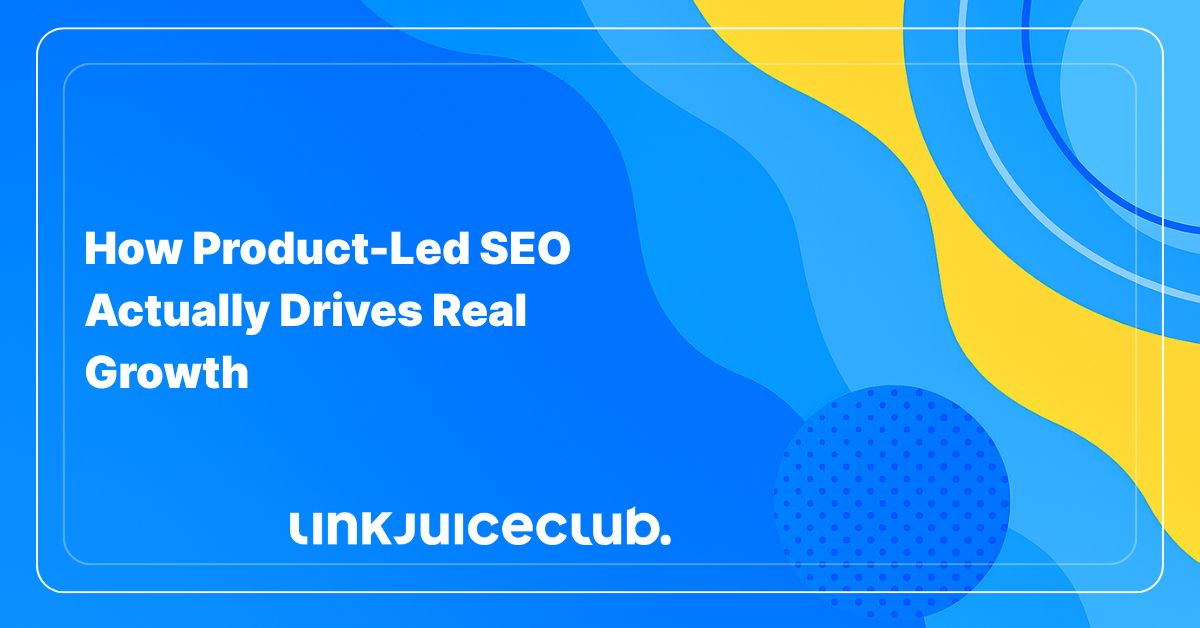
How Product-Led SEO Actually Drives Real Growth
If your SEO strategy feels like you’re dragging in traffic with a net full of holes, it’s probably time to switch tactics. Enter product-Led SEO — a smarter, leaner, and way more relevant approach to getting eyeballs (and wallets) on your site.
Forget chasing bloated keywords with a million monthly searches and zero conversion intent. Product-Led SEO starts where it matters: your product. More specifically, the problems it solves, the users it serves, and the moments it becomes a lifesaver.
Instead of obsessing over search volume, this method builds content that’s rooted in what your users are actively trying to figure out — often using lower-volume queries that pack way more intent. That means fewer vanity metrics, more meaningful clicks, and actual business results you can brag about.

In this guide, we’re unpacking what makes product-driven SEO tick, how to build your strategy around it, and why it’s quickly becoming the go-to move for brands that want to grow without playing the same tired SEO game.
Product-Led SEO: Turning Your Product into a Search Magnet
Product-Led SEO flips the script on how most businesses approach content. Rather than squeezing your product into generic blog posts just to check the “SEO” box, this strategy makes your product the foundation of the entire content experience.
You start by looking at the real-life problems your users are trying to solve — then you build content that shows how your product is the solution. It’s not about ranking for broad, competitive keywords that sound impressive but do nothing for your bottom line. It’s about relevance, clarity, and showing up exactly when and where your ideal users need you.
The twist? Many of the keywords worth targeting with product-driven SEO don’t show up in flashy keyword tools. They’re niche, intent-driven, and often come with lower search volume. But they convert. Hard.
This isn’t just about traffic. It’s about the right traffic, visitors who are more likely to try, buy, and stay. And the reason it works so well? Because you’re not speaking to everyone. You’re speaking to someone specific — someone with a problem your product solves.
How Product-Led SEO Supercharges SaaS Growth
In the world of SaaS, product-driven SEO isn’t just a nice-to-have, it’s how you cut through the noise and pull in users who are actually ready to engage.
Here’s how it plays out: instead of pumping out cookie-cutter blog posts or featureless feature pages, you craft content that lives and breathes your product. That means building blogs, case studies, and landing pages that don’t just mention your software, they show exactly how it solves real problems, for real people.
It also means dialing in your product’s visibility at every touchpoint. From feature-specific landing pages that hit the right search intent to in-app content that’s actually useful (and indexable), everything becomes part of your organic acquisition machine.
Want to take it up a notch? Let your users do some of the heavy lifting. Authentic reviews, product walkthroughs, and strategic free trials or freemium offers don’t just help with conversions, they tick SEO boxes too.
At the end of the day, the goal stays the same: use your product experience to drive discovery, engagement, and growth, all while keeping Google happy. Because when UX and SEO work together, SaaS success isn’t far behind.
Is Product-driven SEO the Move for Your Business?
Let’s be honest, you don’t just want traffic. You want traffic that sticks, converts, and fuels long-term growth. That’s where product-Led SEO shines. It’s not just another tactic; it’s a scalable, cost-smart strategy that helps your business grow from the inside out.
When your product is front and center of your content, you’re building an SEO engine that:
- 🔍 Drives high-intent organic traffic: You’re not casting a wide net, you’re attracting people who are already looking for what you offer.
- 💸 Keeps costs lean — Once it’s live, that content keeps working for you (no ad spend required).
- 📈 Ranks for the stuff that actually matters: No fluff. Just relevant keywords tied directly to real user problems.
- 🚀 Improves conversion rates: You’re matching content to features to intent. That’s SEO alchemy.
- 💡 Boosts brand credibility: Helping users before they even sign up? That builds trust, fast.
Product-driven SEO hits especially hard if you’ve got a product with:
- 🎯 Niche Appeal: If your product serves a laser-specific audience, there’s gold in those low-volume, high-intent searches.
- ✨ Unique Features: Got a feature that solves a problem better than anyone else? There’s content (and traffic) waiting to be made around it.
- 📚 Built-in Value Content: Think templates, generators, toolkits — anything that can be turned into an SEO-optimized asset in its own right.
And once you’ve got this high-converting traffic flowing in? Don’t just celebrate, optimize. Tools like Userpilot let you track what users do after they land, so you can tweak your onboarding, features, and messaging in real-time.
Because with product-driven SEO, the job doesn’t end when someone finds you, that’s just the beginning of the funnel.
5 Product-Led SEO Power Moves (With Real-World Examples That Actually Slap)
Product-driven SEO isn’t a one-size-fits-all playbook. It’s more like a toolbox — and the tool you grab depends on what you’re building. Whether you’re scaling a SaaS platform, an e-com empire, or something in between, there’s a product-led angle that fits your goals.

Here are five powerful ways to turn your product into an organic growth engine — complete with real-world examples that nailed it.
1. Programmatic Landing Pages: The Scalable Traffic Hack
Ever wish you could clone your highest-performing page, change the details, and rank a hundred times over? That’s programmatic SEO in action. You use structured data (think features, locations, use cases) to auto-generate landing pages at scale, all following the same template, just with different content.
Nannybag crushes this. As a luggage storage platform, it automatically spins up pages by creating landing pages for every city where travelers might need to store their luggage. It’s like having a mini-SEO army working for you.
2. Feature Pages That Match Intent with Precision
When someone Googles a specific tool or capability, you want to show up with a page that speaks directly to that feature, no fluff, just value. That’s why feature-focused landing pages are a product-driven SEO staple.
Take Asana, for instance. Instead of just talking about “project management,” they’ve built individual pages for list view, board view, and timeline view, each targeting users searching for those exact workflows. That’s how you grab high-intent traffic and show users what they came for, fast.
3. Inventory Optimization That’s Built for Discovery
If your site has a lot of products, categories, or listings, those pages should be doing more than just holding space. With the right structure, filters, and content, they become SEO assets. Think meta info, structured data, FAQs, and smart keyword targeting, all driven by how users actually search.
Home Depot nails this by optimizing their product finders for terms like “interior paint colors for small bathrooms.” Instead of dumping users into a generic category, they lead with guided experiences that check all the product-driven SEO boxes, relevance, usability, and long-tail visibility.
4. Insight Pages That Turn Data Into Gold
If you’ve got access to unique product data, why not turn it into content that educates, engages, and gets shared like wildfire? This flavor of product-driven SEO transforms internal numbers into valuable insights — content that users actually want to consume (and link to).
Spotify Wrapped is the poster child for this. What started as a quirky year-end summary became a viral, branded content juggernaut. The key? They didn’t create new data, they just repackaged what they already had in a way that felt personal, relevant, and worth talking about.
5. Demos That Let Users Click, Try, and Convert
Letting users test your product before they sign up isn’t just good UX — it’s great SEO. When you embed interactive demos on landing pages, people stay longer, engage more, and get closer to conversion without needing a sales call.
Gong does this beautifully with its product tour. Visitors can explore features like Deal Boards, Timelines, and Filters in a sandbox-style experience that feels intuitive and fun. It’s product-Led SEO in its most engaging form — the content is the product, and the product sells itself.
Product-driven SEO vs Traditional SEO: Can’t We Just Use Both?
Let’s clear the air, this isn’t a cage match. Product-driven SEO and traditional SEO aren’t rivals; they’re just built for different moments in the user journey.
Product-driven SEO is laser-focused on using your actual product, its features, use cases, and content-rich touchpoints, to bring in organic traffic. It thrives when you’re marketing a SaaS platform or any tool that solves a specific problem in a unique way. The magic lies in showing, not just telling. You’re answering real questions with your product, not just about it.
Traditional SEO, on the other hand, plays the long game. It helps you show up for broad informational queries, nurture early-stage awareness, and drive traffic from people who might not even know they need your solution yet. Think guides, comparisons, and top-funnel content that warms up the room.
Want the best of both worlds? Blend them.
- ✨ Use traditional SEO to bring people into the conversation.
- 🔥 Use product-driven SEO to close the deal once they’re interested.
One builds reach, the other builds trust (and conversions).
And here’s the secret sauce: with tools like Userpilot, you can track what this traffic does once it hits your product pages, so you’re not just guessing what works, you’re building a feedback loop that gets smarter every month.
The real power move? Let traditional SEO fill the funnel, and let product-driven SEO turn that traffic into users who stick around.
Make SEO Work With Your Product, Not Around It
If you want long-term organic growth that actually moves the needle, it’s not about choosing between product-driven SEO and traditional SEO, it’s about blending both to their strengths.
Traditional SEO helps you cast a wide net, build visibility, and start the conversation. Product-driven SEO steps in when it counts, turning curious clicks into confident conversions by putting your product at the heart of your content.
Keep your focus on solving real user problems. Build content that mirrors your product’s value. And use data to fine-tune what works.
When you do that?
- 👋 More qualified traffic.
- 💥 Higher conversions.
- 📈 SEO that actually supports your bottom line.
Ready to see product-Led SEO in action? Fire up a Userpilot demo and watch how aligning content with product experience can seriously boost your sales game.





